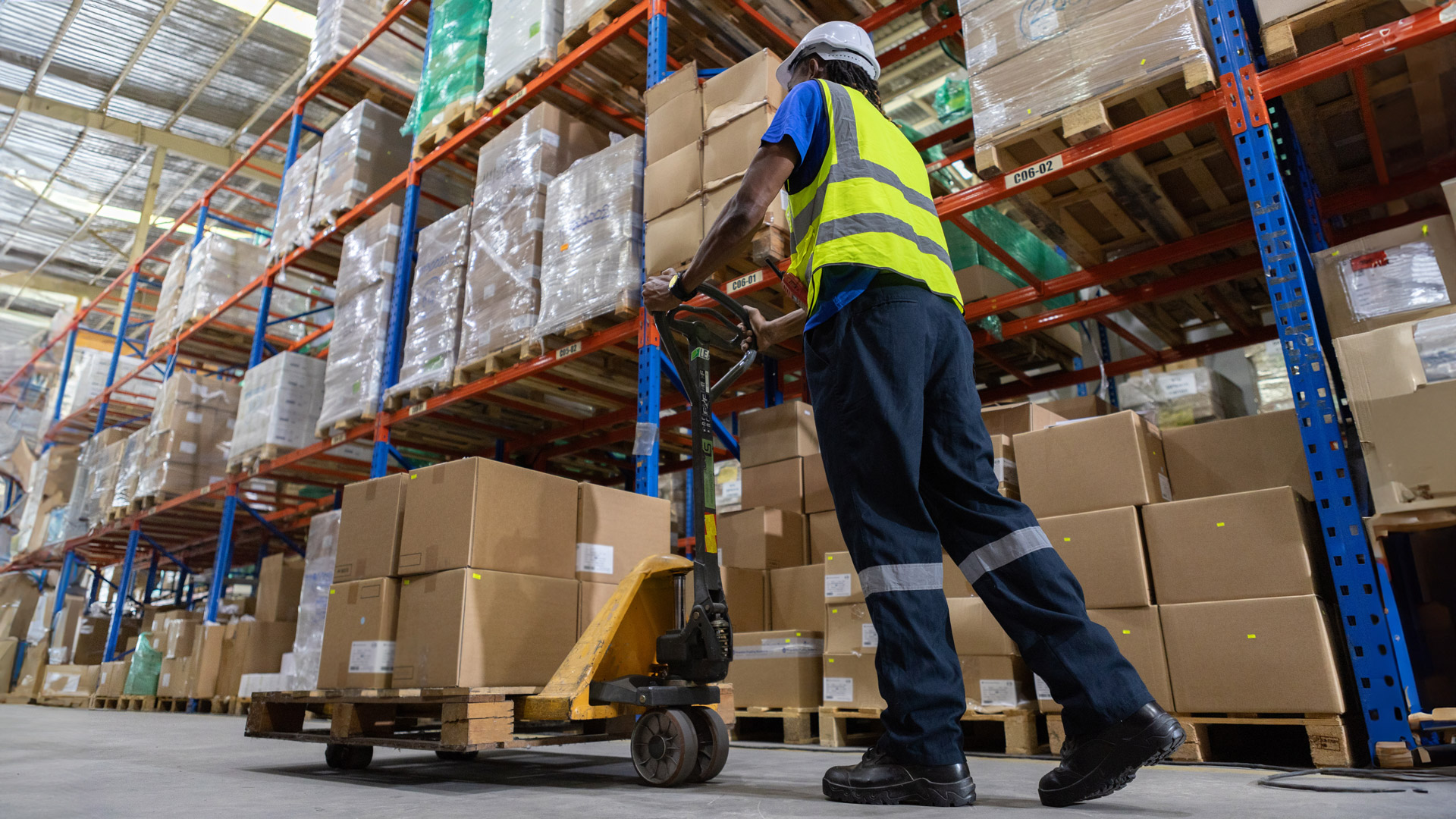INTRODUCTION
Manual handling is a key health and safety concern in the workplace as almost every organisation will have some form of manual handling activities.
Manual handling is responsible for over a third of all workplace injuries. These include work-related musculoskeletal disorders (MSDs) such as pain and injuries to arms, legs and joints, and repetitive strain injuries of various sorts.
Manual handling injuries can be very serious and can occur almost anywhere in the workplace. Heavy manual labour, awkward postures, repetitive movements of arms, legs and the back, as well as existing injuries, can increase the risk.
Manual handling regulations have been well-established for many years, yet many workplaces fail to effectively implement correct manual handling techniques. Failure to ensure the health and safety of employees when working with large or heavy loads can lead to serious injury and may come at a great cost to your business.
Those who undertake manual handling activities are also responsible. This responsibility stretches from risk-assessing activities, to actively participating in training and following agreed techniques.
Overall, the employer must be the driving force to ensure manual handling risk is managed. This guide will help you as a manager to understand the risks.

WHAT IS MANUAL HANDLING?
The term manual handling covers a wide variety of activities, including lifting, lowering, pushing, pulling and carrying. If any of these tasks are not carried out appropriately there is a risk of injury.
- 477,000 workers suffered from a work-related musculoskeletal disorder (new or longstanding) in 2021/22.
- 7.3 million working days were lost due to work-related musculoskeletal disorders in 2021/22.
- Prior to the Coronavirus pandemic, the rate of self-reported work-related musculoskeletal disorders had shown a generally downward trend. The current rate is similar to the 2018/19 pre-Coronavirus levels. In 2021/22 the effects of the Coronavirus pandemic were found to be a contributory factor to work-related musculoskeletal disorders.
- The back was the most common (42%) body area affected by work-related musculoskeletal disorders in 2021/22.
- Handling, lifting or carrying was found to account for 18% of all non-fatal injuries to employees in 2021/22.
- Annual costs of work-related injury and ill health in 2019/20 exceeded £18bn.
- Annual costs of new cases of work-related ill health in 2019/20 exceeded £11bn.
- Annual costs of workplace injury in 2019/20 exceeded £7bn.

MUSCULOSKELETAL DISORDERS AND OTHER INJURIES
Musculoskeletal disorders (MSDs) include injuries and conditions that can affect the back, joints and limbs. Employers must protect workers from the risks of MSDs being caused or made worse by work. You:
- Can do things to prevent or minimise the risk of your workers (and others who may be affected by what they do) developing MSDs, and
- Cannot prevent all MSDs, so early reporting of symptoms, proper treatment and suitable rehabilitation are essential.
If the risk of MSDs exist, you must consider both the requirements for a general risk assessment and specific assessments of other risks, for example, from manual handling.
There are risk factors causing MSDs in many types of work, so you should think about the risks of various tasks:
- Bending, crouching or stooping.
- Lifting heavy or bulky loads.
- Pushing, pulling or dragging heavy loads.
- Stretching, twisting and reaching.
- Repetitive work, particularly using the same hand or arm action.
- Sustained or excessive force.
- Carrying out a task for a long time.
Other common injuries associated with manual handling are:
- Sprains – the painful twisting of the ligaments of a joint.
- Strains or “pulled muscles” – injury to the muscle where the muscle fibres tear.
- Prolapsed discs – a rupture of the cartilage of a spinal disc.
- Hernia – a rupture in the lower abdomen caused by excessive strain on the muscles.
- Crushed limbs – caused by loads falling and trapping limbs.
- Cuts and abrasions – caused by rough, sharp edges on objects.
The major injuries that result from poor manual handling techniques are not only costly but can cause lifelong pain and disfigurement.

WHAT THE LAW SAYS
The Manual Handling Operations Regulations 1992 (as amended) (MHOR) apply to work that involves lifting, lowering, pushing, pulling or carrying.
The MHOR legislation was first introduced in 1992 as part of a series of EC Directives, adopted into UK legislation and updated in 2002.
The Regulations state that an employer must:
- Avoid the need for hazardous manual handling, so far as is reasonably practicable.
- Assess the risk of injury from any manual handling task that cannot be avoided.
- Reduce the risk of injury from manual handling, so far as is reasonably practicable.
The British Safety Council says:
“Employers (and employees) who do not effectively implement these requirements could be subject to a number of actions from the regulatory authorities, dependent upon the nature of the omission(s). There are several actions a Health and Safety Executive inspector can take if they identify a concern or a material breach relating to the manual handling regulations. A minor issue or concern identified may receive informal advice whereas more serious issues (for example a lack of manual handling risk assessment) could result in enforcement action being taken. If an officer believes that there has been a material breach of health and safety regulations, an improvement notice may be issued. If this breach presents a risk of serious injury, then a prohibition notice may be provided which stops the activity from being conducted until the problem has been resolved.
“Many such cases that are subsequently prosecuted can result in a substantial fine (based upon the turnover, size and nature of the organisation) and a custodial sentence in the most serious cases.”

RISK ASSESSMENT
Where it is not possible to avoid handling a load, employers must look at the risks of that task and put sensible health and safety measures in place to prevent and avoid injury.
Taking time to risk assess manual handling activities can often help to eliminate or reduce an activity. If manual handling is required, you’ll have all the information you need to select the most appropriate training to protect your workers.
A ‘competent’ person, or people, can be given the task of carrying out a risk assessment. The goal is to identify the risks in the manual handling task, and then find solutions to either eliminate the manual handling altogether, or to mitigate the risks to reduce the likelihood of injury. Good practice for completing risk assessment is to involve the people who undertake the task as they have day-to-day insight and are more likely to own the risk assessment when it is completed.
Factors to be taken into account for any lifting activity include:
- Task
- Individual capability
- Load
- Environment
For example, consider:
- The postures adopted.
- How far the load is lifted, lowered or carried.
- The frequency of the task.
- The weight of the load.
- The nature of the load (for example hot, sharp or slippery).
- Cramped work areas.
- Poor floor surfaces.
- Poor lighting, extremes of temperature.
- Workers' strength, fitness and underlying medical conditions (for example a history of back problems).
Risk assessment tools are available from the HSE to help you identify high-risk handling operations and prioritise action to control the risks.

CONTROL MEASURES
Measures to control risk will vary depending on the task.
If manual lifting is the only option then there are things you can do to reduce the risk, including:
- Make the load smaller or lighter and easier to grasp.
- Break up large consignments into smaller loads.
- Modify the workplace to reduce carrying distances, twisting movements, or the need to lift things from floor level or above shoulder height.
- Change the work routine to avoid excessive work rates and tight deadlines.
- Improve the environment – more space, better flooring, extra lighting or changing the air temperature can make manual handling easier and safer.
- Make sure the person doing the lifting has been trained to lift as safely as possible.
The hierarchy of control is a health and safety framework that can be used to create a consistent and safe approach to lifting safely and moving objects or people in the workplace.
The hierarchy of control works as a checklist to ensure that the appropriate steps are in place when undertaking manual handling at work.

THE HIERARCHY OF CONTROL
1. Avoid the need for manual handling (Elimination).
There are cases in which manual handling cannot be avoided in the workplace. However, it is important to first assess how necessary it is for employees to manually handle loads as part of their work.
2. Reduce the load (Substitution)
Substituting heavy loads for lighter items lowers the risks associated with manual handling as the item then becomes much easier to carry and therefore poses less of a risk.
3. Reorganise the activity or environment or utilise mechanical lifting aids or equipment (Engineering Controls)
Reorganising the workplace can ensure that layouts require little to no manual handling as everything is already in place and can remain where it is. Depending on the type of manual handling required, you may be able to use lifting equipment to move items and loads and replace the need for staff to undertake manual handling.
4. Ensure appropriate rest breaks and proper training (Administrative Controls)
Knowing how employees work and how to best meet their needs is essential for creating a safe working environment. In cases where manual handling cannot be avoided, training and instruction should be available for staff.
5. Provide PPE (Personal Protective Equipment)
Lifting heavy loads in tight clothing can become restrictive, which can then result in injury. Wearing slippery footwear may also lead to an accident as there is more chance of the individual falling. Hand and foot protection is useful PPE, to ensure that the employee has a good grip on items and maintains steady footing whilst carrying loads.

TECHNIQUES FOR LIFTING
The HSE offers the following tips on safe lifting techniques:
- Think before lifting/handling. Plan the lift. Can handling aids be used? Where is the load going to be placed? Will help be needed with the load? Remove obstructions such as discarded wrapping materials. For a long lift, consider resting the load midway on a table or bench to change grip.
- Adopt a stable position. The feet should be apart with one leg slightly forward to maintain balance (alongside the load, if it is on the ground). Workers should be prepared to move their feet during the lift to maintain stability. Avoid tight clothing or unsuitable footwear, which may make this difficult.
- Get a good hold. Where possible, the load should be hugged as close as possible to the body. This may be better than gripping it tightly with hands only.
- Start in a good posture. At the start of the lift, slight bending of the back, hips and knees is preferable to fully flexing the back (stooping) or fully flexing the hips and knees (squatting).
- Don't flex the back any further while lifting. This can happen if the legs begin to straighten before starting to raise the load.
- Keep the load close to the waist. Keep the load close to the body for as long as possible while lifting. Keep the heaviest side of the load next to the body. If a close approach to the load is not possible, try to slide it towards the body before attempting to lift it.
- Avoid twisting the back or leaning sideways, especially while the back is bent. Shoulders should be kept level and facing in the same direction as the hips. Turning by moving the feet is better than twisting and lifting at the same time.
- Keep the head up when handling. Look ahead, not down, at the load once it has been held securely.
- Move smoothly. The load should not be jerked or snatched as this can make it harder to keep control and can increase the risk of injury.
- Don't lift or handle more than can be easily managed. There is a difference between what people can lift and what they can safely lift. If in doubt, seek advice or get help.
- Put down, then adjust. If precise positioning of the load is necessary, put it down first, then slide it into the desired position.
Case study
A manufacturing company kept bulky chemicals stored in heavy tubs at floor and shoulder height. This meant that operatives were continually reaching down or up, both of which increase the risk of injury.
To address the risk, the company drew up guidelines on the storage of heavy loads to ensure they are now stored at waist height, which makes lifting and handling easier.

TRAINING
Training can be important in raising awareness and reducing risk, when used in combination with other safety factors.
Training can be tailored to the type of work carried out and should cover:
- Manual handling risk factors and how injuries can happen.
- How to use mechanical aids.
- How to carry out safe manual handling, including good handling techniques.
- Systems of work relevant to the worker's tasks and environment.
- Practical work so the trainer can identify anything the trainee is not doing safely and put it right.
International Workplace’s Manual Handling training course helps learners understand the risks and dangers associated with lifting and handling in the workplace and identify the steps that can be taken to reduce and control the risks and likelihood of injury.

KEY TAKEAWAYS
-
Almost every organisation in any sector will involve some form of manual handling activities.
-
Manual handling is responsible for over a third of all workplace injuries.
-
Manual handling injuries can have serious implications for the employer and the person who has been injured.
-
The term manual handling covers a wide variety of activities including lifting, lowering, pushing, pulling and carrying.
-
There are several actions an HSE inspector can take if they identify a concern or a material breach relating to the Manual Handling Regulations.
-
The Regulations state that employers must avoid, assess and reduce the risk of injury due to manual handling.
-
A risk assessment must be carried out to identify the risks in the manual handling task.
-
The hierarchy of control works as a checklist to ensure that the appropriate steps are in place when undertaking manual handling at work.
-
There are lifting techniques that can be adopted to reduce the risk of injury.
-
Employers must protect workers from the risks of musculoskeletal disorders (MSDs) being caused or made worse by work.
-
Training can be important in raising awareness and reducing risk, when used in combination with other safety factors.
SOURCES:
You might also be interested in
RELATED CONTENT
RELATED COURSES

The world’s best-known health and safety certificate, designed for managers and supervisors in any sector or organisation.

IOSH Working Safely is a one-day introductory health and safety training course for people at any level, in any sector.

Introduction to health and safety gives learners a basic introduction to managing safety in their workplace.

The Manual handling course helps learners understand the risks and dangers associated with lifting and handling in the workplace.

Moving and handling heavy or bulky objects at work is needlessly harming the health of tens of thousands of workers every year, according to a new cam...

There are lots of myths around manual handling, including what constitutes manual handling and the effects poor practice can have on the body and mind...

A company has been fined after shocked onlookers spotted an employee precariously working from height while standing on a pallet raised by a forklift ...

The HSE has issued guidance on musculoskeletal disorders, specifically in the catering and hospitality industries.
